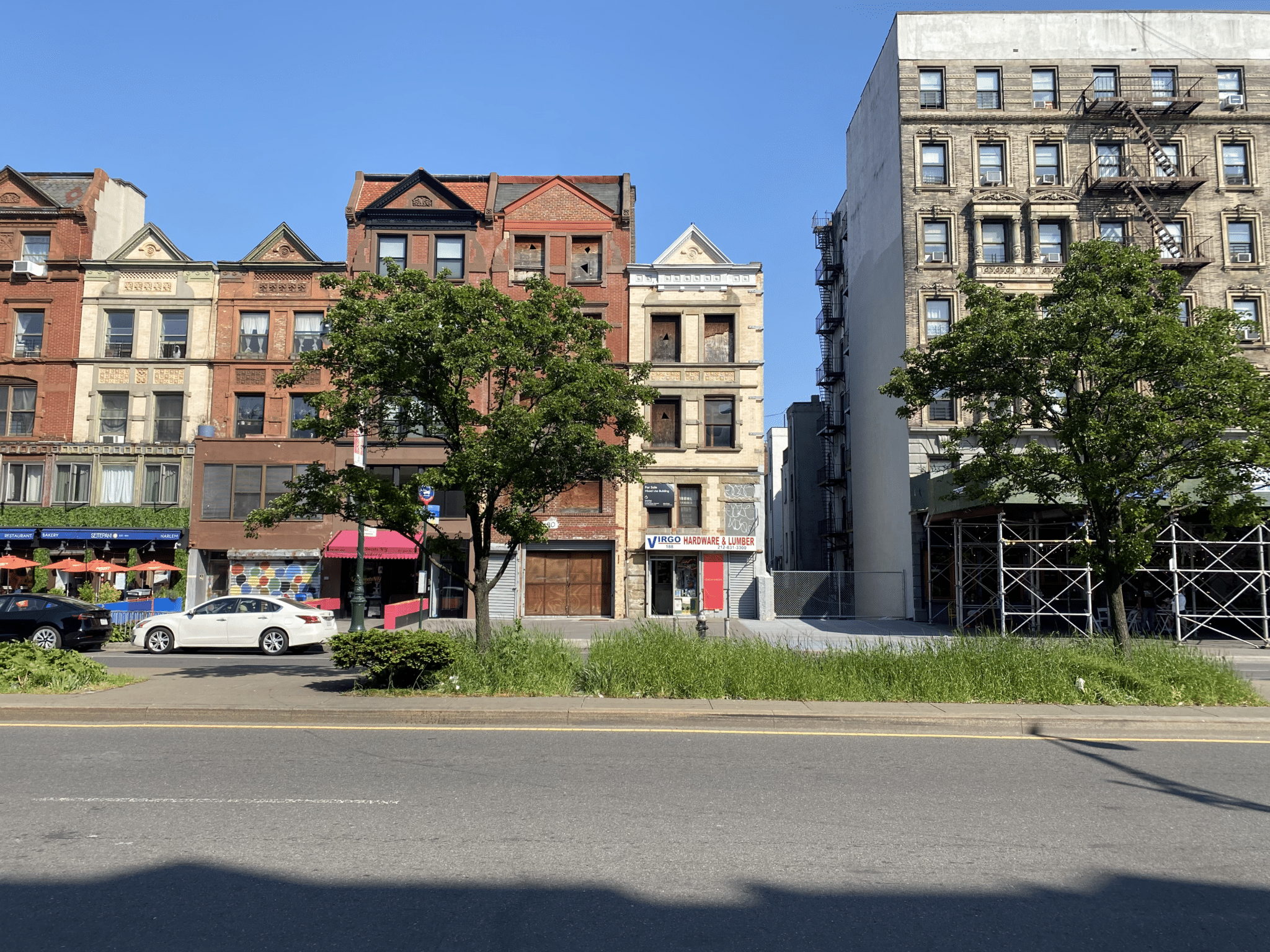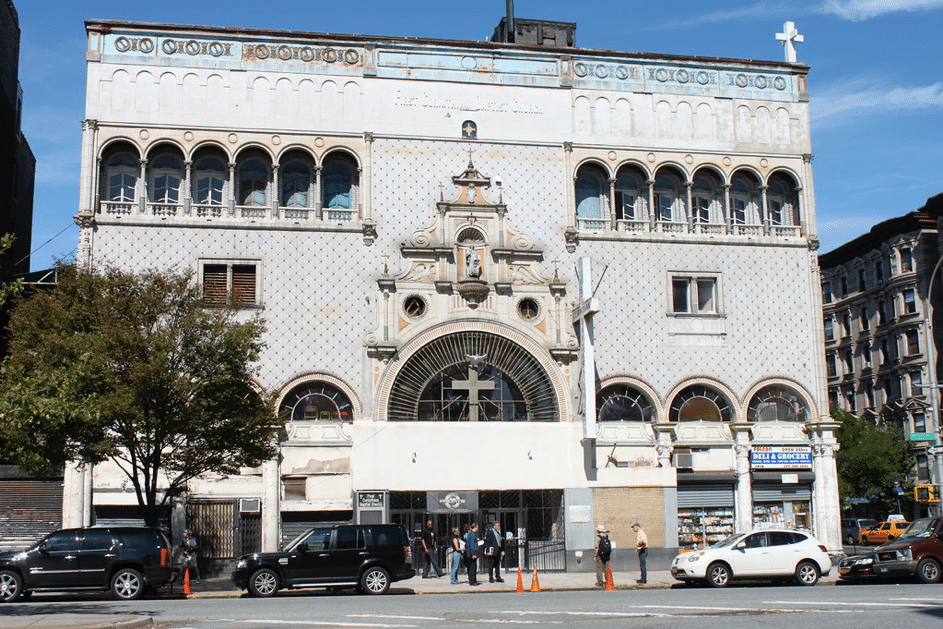Lenox Avenue in Harlem lost one of its older buildings when the DOB ordered it demolished to prevent its inevitable collapse onto the sidewalk. Photo by Laura Lego.
The three-story rowhouse sat along Lenox Avenue for more than a century. It and other brownstone houses, along with churches, make up the historic character of Mount Morris Park District in Harlem, a 16-block historic district in west central Harlem.
But time was not kind to the building. Last year, after the chimney shifted and the ceiling caved in, the Department of Buildings (DOB) ordered it demolished to prevent its inevitable collapse onto the sidewalk.
Residents feel this destruction is yet another sign of the steady disappearance of the historical and architectural heritage of Harlem.
“My children won’t be able to see things that were here when I was younger,” said Lorena, a 35-year-old woman born and raised in Harlem.
Local public officials are trying to take action to stop this loss. Preserving the history and heritage of Harlem is one of the goals of Community Board 10, which passed a resolution calling on the Landmarks Preservation Commission to implement new protocols. They hope the neighborhood’s historic buildings will be better protected from deterioration and demolition.
In the last 10 years, about 100 buildings have been destroyed in Harlem. The DOB usually orders these demolitions when the buildings pose safety problems for pedestrians and neighbors. Of these, at least six were in neighborhoods now designated as historic districts by the Landmarks Preservation Commission.
Keith Taylor, Chair of the Transportation, Historic Preservation, and Landmarks Committee of Community Board 10 is concerned that there are a lot of buildings in historic districts that are vacant and deteriorating yet nothing is being done to restore them. He anticipates that the destruction of these buildings will become more frequent if the authorities do not act.
“When we lose these buildings, it is not just an architectural loss, but also who lived there, organizations that planned things in these buildings, efforts to change the world that occurred in this Harlem community,” said Taylor.
To deal with these demolitions, Community Board 10 voted unanimously in February for a resolution to preserve the historical and architectural heritage of Harlem. The resolution highlights three requests. The first one is better financial support for owners of historic buildings, to help them preserve and renovate the buildings. Second, they ask for more transparency on the part of the agencies in charge of these issues to allow the community to react before the destruction of a building. Finally, they request the creation of a program that appoints a public administrator to address the problems of a particularly deteriorated building.
But then the question arises: has nothing been put in place to protect the landmarks of Harlem? In fact, the Landmarks Preservation Commission oversees designating historic neighborhoods that are supposed to be protected from demolition. But Taylor argues that “Harlem has been neglected regarding community preservation,” as the percentage of preserved buildings is much lower than in other parts of the city.
And judging by the statistics, this is true. In 2014, Community Board 10 drafted a Comprehensive Historic Preservation Plan for the district. As of that date, only 3.6% of the district was part of a historic district, compared to 45% at the time for the West Village or 26% for the Upper West Side. Since then, the Landmarks Preservation Commission has created four new historic districts in Harlem, the latest being Dorrance Brooks Square in 2021, a north Harlem neighborhood next to the City College of New York.
With these new historic districts, the proportion of historic buildings in Harlem has increased significantly, but this is not enough according to the non-profit organization “Save Harlem Now!” For them, the designation of historic buildings in Harlem is still far too slow. They plead for “swift action to designate what should have been designated decades ago, to catch up with the rate of designations in other downtown neighborhoods, and to regulate additions and alterations in a rapidly changing Harlem.”
Harlem is indeed a neighborhood that is constantly changing, with the construction of modern buildings. But residents want to see the same attention given to the older buildings.
“Part of the beauty of Harlem is all the old buildings and you see all of the new buildings come,” said Oliver Leventis, 23, a resident born and raised in Harlem. “But it would be nice to see the old ones renovated and brought back to life”.
Critics point to the Landmarks Preservation Commission as not doing enough to preserve Harlem’s cultural and historical heritage.
“It is a shame that the city of New York along with agencies, The Department of Buildings [and the] Landmark Preservation [Commission], does not maintain or enforce the owners to maintain the buildings so they don’t fall apart,” said Panayotis Leventis, Oliver’s father.
The Landmark Preservation Commission spokesperson said the Commission, in conjunction with the Department of Buildings, is currently working on an action plan to do a better job in preserving the city’s historic buildings. Among other measures, the plan will focus on earlier detection of risks and will increase coordination with DOB and communication with communities.
Taylor believes the city and the agencies in charge of these issues need to do more by pursuing “both purposes of preserving the structures and also a service to the community by preserving economic diversity in the neighborhood.”
Oliver agrees. “The future of Harlem really depends on what new laws and regulations get enforced by the city in order to maintain and renovate beautiful landmarks in Harlem,” he said. “If this doesn’t happen, a lot of landmark buildings that hold so much history will be lost.”
Tags: Community Board Harlem Department of Buildings designated historic district DOB Harlem Harlem landmarks Landmark buildings Landmark Preservation Commission Laura Lego Save Harlem Now!
Series: Community

